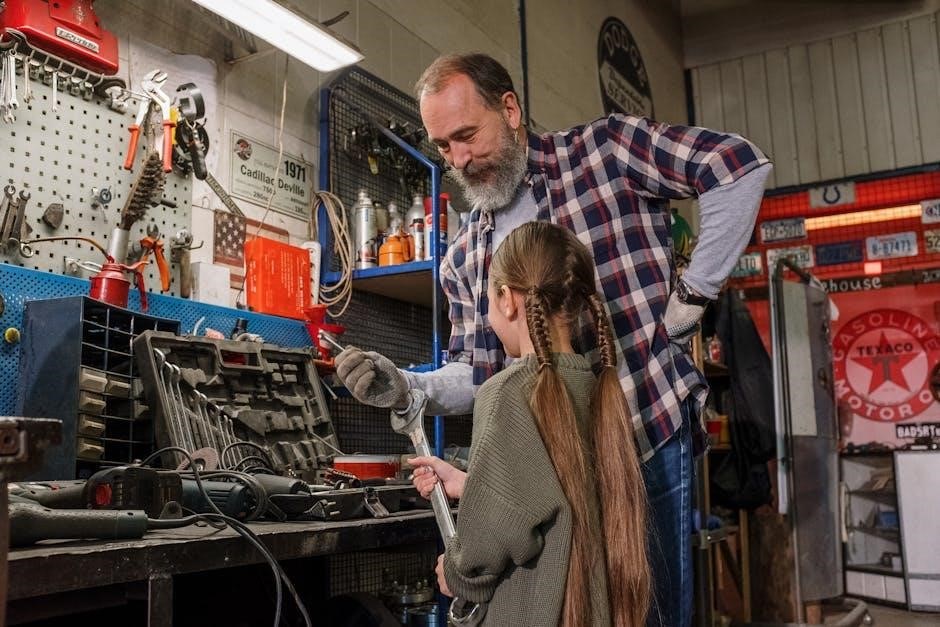The Fisher 667 actuator is a reliable, spring-opposed diaphragm actuator designed for precise control in various industrial applications. It is widely used in oil, gas, and chemical industries due to its versatility and durability. The actuator is available in multiple sizes, including 30, 30i, 76, 76i, and 87, catering to different operational requirements. Emerson, the manufacturer, provides detailed instruction manuals for installation, maintenance, and troubleshooting, ensuring optimal performance and safety. This guide serves as a comprehensive resource for understanding and utilizing the Fisher 667 actuator effectively.
Overview of the Fisher 667 Actuator
The Fisher 667 actuator is a spring-opposed, diaphragm-type actuator designed for precise control in industrial valve applications. Available in sizes 30, 30i, 76, 76i, and 87, it offers flexibility for various operating conditions. Its compact design and durability make it suitable for oil, gas, chemical, and power industries. The actuator operates reliably in harsh environments, providing consistent performance. It is compatible with Fisher positioners and accessories, ensuring seamless integration into control systems. This actuator is a key component for achieving accurate valve positioning and process control.
Key Features and Applications
The Fisher 667 actuator features a robust spring-opposed diaphragm design, offering precise control and reliability in industrial applications. It is ideal for use in oil, gas, chemical, and power industries, where consistent valve operation is critical. The actuator supports both linear and rotary valve configurations, making it versatile for diverse process needs. Its compact size and high thrust output ensure efficient performance in challenging environments. Additionally, it is compatible with various positioners and control systems, enhancing its adaptability for complex process requirements.

Installation of the Fisher 667 Actuator
The Fisher 667 actuator installation requires careful adherence to the instruction manual, ensuring proper handling and setup for optimal performance and safety in industrial environments.
Pre-Installation Requirements and Preparation
Before installing the Fisher 667 actuator, thoroughly review the instruction manual to ensure compatibility with your system. Inspect the actuator for any damage or debris and clean the area. Verify that the actuator size matches the valve specifications. Check environmental conditions, such as temperature and humidity, to ensure they align with the actuator’s operational limits. Gather all required tools and materials, and refer to the torque specifications for proper connections. Ensure compliance with safety guidelines to prevent accidents during installation.
Step-by-Step Installation Guide
Mount the Fisher 667 actuator to the valve body using the provided bolts, ensuring alignment with the valve stem. Tighten the bolts in a star pattern to the specified torque. Connect the control signal lines, ensuring proper polarity and wiring. Attach the positioner or controller, if applicable, following the manufacturer’s instructions. Install the handwheel or other control accessories securely. Test the actuator’s operation under no load to confirm smooth movement. Refer to the instruction manual for specific configurations and adjustments.
Post-Installation Checks and Testing
After installing the Fisher 667 actuator, perform a series of checks to ensure proper function. Verify that all bolts are tightened to the specified torque and that the valve stem is correctly aligned. Test the actuator’s response to control signals, ensuring smooth and precise movement. Check for any air or hydraulic leaks in the system. Perform a full range-of-motion test under no load to confirm proper operation. Refer to the instruction manual for detailed testing procedures and specifications.

Adjustment and Commissioning
The Fisher 667 actuator requires precise calibration and setup for optimal performance. Follow the instruction manual for initial adjustments and commissioning to ensure accurate control.
Calibration and Initial Setup
Calibration and initial setup of the Fisher 667 actuator are critical for ensuring precise control and optimal performance. Follow the instruction manual for detailed steps on setting the spring tension, adjusting the yoke, and aligning the actuator with the valve. Proper calibration ensures accurate response to control signals, while initial setup defines the actuator’s operational parameters. Refer to Emerson’s guidelines for specific procedures and safety precautions during this process to achieve reliable and consistent operation.
Tuning the Actuator for Optimal Performance
Tuning the Fisher 667 actuator ensures it operates efficiently and meets specific application requirements. Refer to the instruction manual for detailed procedures on adjusting parameters like response time, stability, and precision. Fine-tune the actuator by calibrating the spring tension and ensuring proper alignment with the valve. Regular adjustments may be needed to maintain optimal performance. Always follow Emerson’s guidelines to avoid over-tightening or misalignment, which can compromise actuator reliability and operational efficiency. Precision tuning enhances dynamic performance and ensures consistent control.
Maintenance and Troubleshooting
Regular maintenance of the Fisher 667 actuator includes lubricating moving parts, inspecting the diaphragm, and checking for wear; Follow Emerson’s guidelines for troubleshooting common issues promptly.
Scheduled Maintenance Tasks
Regular lubrication of moving parts and inspection of the diaphragm are essential. Check for wear on components like screws and washers. Ensure proper tightening of all connections. Inspect the actuator’s spring for damage and test the travel stops. Refer to Emerson’s guidelines for specific intervals. Cleaning and replacing worn seals prevent leaks. These tasks ensure optimal performance, reliability, and safety of the Fisher 667 actuator in industrial applications.
Common Issues and Diagnostic Procedures
Common issues with the Fisher 667 actuator include diaphragm damage, air leakage, and improper spring tension. Diagnose by inspecting for visible wear or cracks in the diaphragm. Check air supply lines for blockages or connections for tightness. Test spring tension by manually moving the actuator. Refer to the Emerson manual for troubleshooting charts. Addressing these issues promptly ensures smooth operation and prevents costly downtime. Regular inspections help identify problems before they escalate;

Parts and Accessories
The Fisher 667 actuator offers a range of parts and accessories, including diaphragms, springs, and yoke bosses. Emerson provides replacement kits and upgrade options for enhanced performance. Compatible accessories ensure optimal functionality across various applications. Refer to the instruction manual for detailed part numbers and ordering information to maintain and upgrade your actuator efficiently.
Ordering Replacement Parts
For the Fisher 667 actuator, ordering replacement parts requires consulting the instruction manual to identify correct part numbers. Emerson provides detailed catalogs and lists to ensure accurate ordering. Contact Emerson sales or authorized distributors for assistance. Use the specified part numbers to avoid compatibility issues. Always verify the compatibility of replacement parts with your actuator size and configuration before placing an order. This ensures optimal performance and safety.
Compatible Accessories and Upgrades
The Fisher 667 actuator supports a range of compatible accessories to enhance functionality. These include valve positioners, handwheel kits, and travel stop assemblies. Emerson offers upgrade kits for modernizing older models, ensuring compatibility with advanced control systems. Additional components like digital interfaces and mounting adapters are available to customize the actuator for specific applications. Always refer to the instruction manual or consult Emerson representatives for the latest accessory options and compatibility details.
Safety Guidelines and Precautions
Adhere to all safety guidelines in the instruction manual to ensure safe operation. Avoid high-pressure water jets on electrical components and follow proper handling procedures to prevent damage or injury.
General Safety Recommendations
Always comply with the instruction manual and follow safe work practices. Ensure proper installation and maintenance to prevent operational hazards. Use only genuine Fisher parts to maintain reliability. Avoid exceeding the actuator’s load limits to prevent damage. Wear personal protective equipment when handling the actuator. Keep the area clean and well-ventilated to minimize risks. Follow all safety precautions to ensure safe and efficient operation of the Fisher 667 actuator.
Handling and Storage Best Practices
Handle the Fisher 667 actuator with care to avoid damage. Store it in a clean, dry, and climate-controlled environment. Avoid exposure to harsh chemicals or extreme temperatures. Use the original packaging for transportation to prevent damage. Ensure the actuator is securely fastened during shipping. Follow the instruction manual for proper handling procedures. Regularly inspect stored units for signs of wear or damage. Maintain proper storage conditions to ensure optimal performance when the actuator is installed.

Technical Specifications
The Fisher 667 actuator is available in sizes 30, 70, 80, and 100, with nominal effective diaphragm areas ranging from 677 cm² to 2065 cm². Maximum allowable output thrust varies by size, ensuring precise control in industrial applications. Refer to the instruction manual for detailed specifications and performance parameters.
Actuator Sizes and Configurations
The Fisher 667 actuator is available in various sizes, including 30, 30i, 76, 76i, and 87, to suit different operational needs. Size 30 offers a nominal effective diaphragm area of 677 cm², while size 87 provides 320 inch². Configurations include side-mounted handwheels and casing-mounted travel stops, enhancing versatility. Each size is designed for specific applications, ensuring optimal performance across industries. The instruction manual details these configurations, aiding in proper selection and installation.
Performance Parameters and Limits
The Fisher 667 actuator operates as a reverse-acting, spring-opposed diaphragm actuator, delivering precise control across various applications. Key performance parameters include maximum allowable output thrust, which varies by size, and nominal effective diaphragm areas ranging from 677 cm² for size 45 to 320 inch² for size 87. The actuator is designed to handle specific pressure limits and operating conditions, ensuring reliable performance. Always consult the instruction manual for detailed specifications and operational limits to maintain safety and durability.
The Fisher 667 actuator, supported by its comprehensive instruction manual, ensures reliable performance and safety in industrial applications. Adherence to the manual guarantees optimal functionality and longevity.
Final Tips for Effective Use
Always adhere to the Fisher 667 instruction manual for optimal performance. Regularly inspect and maintain the actuator to ensure longevity. Proper sizing and installation are crucial for safe operation. Use genuine replacement parts for reliability; Follow safety guidelines to prevent accidents. Refer to Emerson’s resources for troubleshooting and updates. By following these tips, users can maximize the actuator’s efficiency and extend its operational life while ensuring compliance with industry standards.
Resources for Further Assistance
For additional support, refer to the Fisher 667 instruction manual available on Emerson’s official website. Download the PDF for detailed specifications, troubleshooting, and maintenance guides. Contact Emerson’s sales office or local distributors for personalized assistance. Visit www.emerson.com for the latest updates and resources. Ensure to consult document numbers like D100310X012 for specific actuator models and sizes. These resources provide comprehensive support for optimal actuator performance and maintenance.


